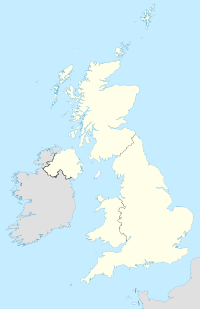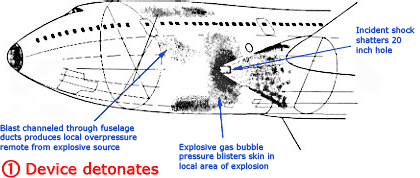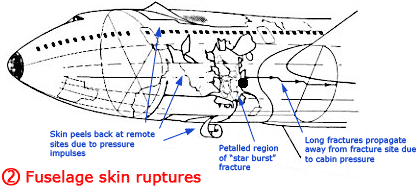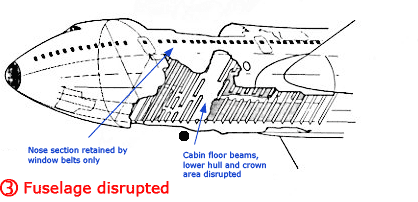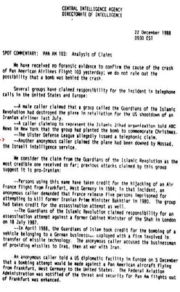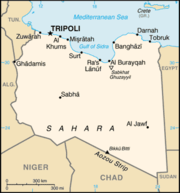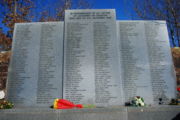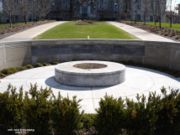Pan Am Flight 103
2008/9 Schools Wikipedia Selection. Related subjects: Recent History
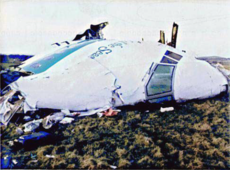 |
|
| Summary | |
|---|---|
| Date | 21 December 1988 |
| Type | Terrorist bombing |
| Site | Lockerbie, Scotland |
| Passengers | 243 |
| Crew | 16 |
| Fatalities | 270 (259 in aircraft, and including 11 on ground) |
| Survivors | 0 |
| Aircraft type | Boeing 747-121 |
| Aircraft name | Clipper Maid of the Seas |
| Operator | Pan American World Airways |
| Tail number | N739PA |
| Flight origin | London Heathrow Airport |
| Destination | John F. Kennedy International Airport |
Pan Am Flight 103 was Pan American World Airways' third daily scheduled transatlantic flight from London's Heathrow International Airport to New York's John F. Kennedy International Airport. On Wednesday 21 December 1988, the aircraft flying this route—a Boeing 747-121 named Clipper Maid of the Seas—was destroyed by a bomb. The remains landed in and around the town of Lockerbie in southern Scotland.
In the subsequent investigation of the crash, forensic experts determined that about 1 lb (450 g) of plastic explosive had been detonated in the airplane's forward cargo hold, triggering a sequence of events that led to the rapid destruction of the aircraft. Winds of 100 knots (190 km/h) scattered victims and debris along a 130 km (80 mile) corridor over an area of 2189 km² (845 square miles).
The death toll was 270 people from 21 countries, including 11 people in Lockerbie.
Criminal inquiry
Known as the Lockerbie bombing and the Lockerbie air disaster in the UK, it became the subject of Britain's largest criminal inquiry, led by its smallest police force, Dumfries and Galloway Constabulary. Since 189 of the victims were American, the bombing stood as the deadliest terrorist attack against the United States until the September 11, 2001 attacks.
After a three-year joint investigation by the Dumfries and Galloway Constabulary and the U.S. Federal Bureau of Investigation, during which 15,000 witness statements were taken, indictments for murder were issued on November 13, 1991, against Abdel Basset Ali al-Megrahi, a Libyan intelligence officer and the head of security for Libyan Arab Airlines (LAA), and Lamin Khalifah Fhimah, the LAA station manager in Luqa Airport, Malta. United Nations sanctions against Libya and protracted negotiations with the Libyan leader Colonel Muammar al-Gaddafi secured the handover of the accused on April 5, 1999 to Scottish police at Camp Zeist, Netherlands, chosen as a neutral venue.
On January 31, 2001, Megrahi was convicted of murder by a panel of three Scottish judges, and sentenced to 27 years in prison. Fhimah was acquitted. Megrahi's appeal against his conviction was refused on March 14, 2002, and his application to the European Court of Human Rights was declared inadmissible in July 2003. On September 23, 2003, Megrahi applied to the Scottish Criminal Cases Review Commission (SCCRC) for his conviction to be reviewed, and for his case to be referred back to the High Court for a fresh appeal. On June 28, 2007, the SCCRC announced its decision to refer the case to the Court of Criminal Appeal after it found he "may have suffered a miscarriage of justice".
Megrahi is serving his sentence in Greenock Prison, where he continues to profess his innocence.
Flight plan
Pan Am Flight 103 was a Boeing 747-100 named Clipper Maid of the Seas. The jumbo jet was the fifteenth 747 ever built and was delivered in February 1970, one month after the very first 747 had entered service with Pan Am.
On Wednesday December 21, 1988, Clipper Maid of the Seas touched down at London's Heathrow Airport at noon from San Francisco. The aircraft was parked at stand K-16, Terminal 3, was guarded for two hours by Pan Am's security company, Alert Security, but otherwise was not watched.
The first leg of Pan Am Flight 103's journey began as the Boeing 727 feeder flight, PA103A, from Frankfurt International Airport, West Germany to London Heathrow. Forty-seven of the 89 passengers on PA103A transferred at Heathrow to the Boeing 747 flight PA103 which was scheduled to fly to New York JFK. A Boeing 727 would have been used on the final leg from JFK to Detroit.
There were 243 passengers and 16 crew members on board, led by the pilot Captain James Bruce "Jim" MacQuarrie, First Officer Raymond Ronald "Ray" Wagner, and Flight Engineer Jerry Don Avritt. Mary Murphy served as the head purser. The flight was scheduled to depart at 18:00, and pushed back from the gate at 18:04, but because of a rush-hour delay, it took off from runway 27L at 18:25, flying northwest out of Heathrow, a so-called Daventry departure. Once clear of Heathrow, the crew steered due north toward Scotland. At 18:56, as the aircraft approached the border, it reached its cruising altitude of 31,000 ft (9400 m), and MacQuarrie throttled the engines back to cruising power.
At 19:00, PA103 was picked up by the Scottish Area Control Centre at Prestwick, Scotland, where it needed clearance to begin its flight across the Atlantic Ocean. Alan Topp, an air traffic controller, made contact with the clipper as it entered Scottish airspace.
Captain MacQuarrie replied: "Good evening Scottish, Clipper one zero three. We are at level three one zero." Then First Officer Wagner spoke: "Clipper 103 requesting oceanic clearance." Those were the last words heard from the aircraft.
Explosion
At 19:01, Topp watched Flight 103 approach the corner of the Solway Firth, and at 19:02, it crossed its northern coast. On his scope, the aircraft showed transponder code or "squawk"—0357 and flight level—310. When the airliner's transponder stopped replying, it was flying at 31,000 ft (9400 m) on a heading of 316 degrees magnetic, and at a speed of 313 knots (580 km/h) calibrated airspeed, at 19:02:46.9. Subsequent analysis of the radar returns by RSRE concluded that the aircraft was tracking 321° (grid) and travelling at a ground speed of 434 knots (804 km/h).
At that moment, SSR contact with the aircraft was lost. Topp tried to make contact with Captain MacQuarrie, and asked a nearby KLM flight to do the same, but there was no reply. Where there should have been one radar return on his screen, there were four, and as the seconds passed, the returns began to fan out. Comparison of the cockpit voice recorder with the radar returns showed that 8 seconds after the explosion, wreckage had a 1-nautical mile (2 km) spread.
A minute later, the wing section containing 200,000 lb (91,000 kg) of fuel hit the ground at Sherwood Crescent, Lockerbie. The British Geological Survey at nearby Eskdalemuir registered a seismic event measuring 1.6 on the Richter scale as all trace of two families, several houses, and the 196 ft (60 m) wing of the aircraft disappeared. British Airways pilot Captain Robin Chamberlain, flying the Glasgow–London shuttle near Carlisle, called Scottish to report that he could see a huge fire on the ground. The destruction of PA103 continued on Topp's screen, by now full of returns moving eastwards with the wind.
Aircraft breakup
The explosion punched a 20-inch (0.51 m) wide hole, almost directly under the P in Pan Am, on the left side of the fuselage. The disintegration of the aircraft was rapid. Investigators from the Air Accidents Investigation Branch (AAIB) of the British Department of Transport concluded that the nose of the aircraft separated from the main section within three seconds of the explosion.
The cockpit voice recorder, a recording device in the tail section of the aircraft, was found in a field by police searchers within 24 hours of the bombing. There was no evidence of a distress call: a 180- millisecond hissing noise could be heard as the explosion destroyed the aircraft's communications centre.
After being lowered into the cockpit in Lockerbie before it was moved, and while the bodies of the flight crew were still inside it, investigators from the U.S. Federal Aviation Administration (FAA) concluded that no emergency procedures had been started. The pressure control and fuel switches were both set for cruise, and the crew had not used their oxygen masks, which would have descended within five seconds of a rapid depressurisation of the aircraft.
The nerve centre of a 747, from which all the navigation and communication systems are controlled, is below the cockpit, separated from the forward cargo hold by a bulkhead wall. Investigators concluded that the force of the explosion broke through this wall and shook the flight-control cables, causing the front section of the fuselage to begin to roll, pitch, and yaw.
These violent movements snapped the reinforcing belt that secured the front section to the row of windows on the left side and it began to break away. At the same time, shock waves from the blast ricocheted back from the fuselage skin in the direction of the bomb, meeting pulses still coming from the initial explosion. This produced Mach stem shock waves, calculated to be 25% faster than, and double the power of, the waves from the explosion itself. These shock waves rebounded from one side of the aircraft to the other, running down the length of the fuselage through the air-conditioning ducts and splitting the fuselage open. A section of the 747's roof several feet above the point of detonation peeled away. The Mach stem waves pulsing through the ductwork bounced off overhead luggage racks and other hard surfaces, jolting the passengers.
The power of the explosion was increased by the difference in air pressure between the inside of the aircraft, where it was kept at breathable levels, and outside, where it was about a quarter of that at sea level. The nose of the aircraft, containing the flight crew and the first class section, broke away, striking the No. 3 Pratt & Whitney engine as it snapped off.
Investigators believe that within three seconds of the explosion, the cockpit, fuselage, and No. 3 engine were falling separately. The fuselage continued moving forward and down until it reached 19,000 ft (6000 m), at which point its dive became almost vertical.
As it descended, the fuselage broke into smaller pieces, with the section attached to the wings landing first in Sherwood Crescent, where the aviation fuel inside the wings ignited, causing a fireball that destroyed several houses, and which was so intense that nothing remained of the left wing of the aircraft. Investigators were able to determine that both wings had landed in the crater after counting the number of large steel flap drive jackscrews that were found there.
Victims
Passengers and crew
All 243 passengers and 16 crew members were killed. A Scottish Fatal Accident Inquiry, which opened on October 1, 1990, heard that, when the cockpit broke off, tornado-force winds tore through the fuselage, tearing clothes off passengers and turning insecurely fixed items like food and drink trolleys into lethal objects. Because of the sudden change in air pressure, the gases inside the passengers' bodies would have expanded to four times their normal volume, causing their lungs to swell and then collapse. People and objects not fixed down would have been blown out of the aircraft into the −46 °C (−50 °F) outside air, their 31,000-ft (9400 m) fall lasting about two minutes. Some passengers remained attached to the fuselage by their seat belts, landing in Lockerbie strapped to their seats.
Although the passengers would have lost consciousness through lack of oxygen, forensic examiners believe some of them might have regained consciousness as they fell toward oxygen-rich lower altitudes. Forensic pathologist Dr. William G. Eckert, director of the Milton Helpern International Centre of Forensic Sciences at Wichita State University, who examined the autopsy evidence, told Scottish police he believed the flight crew, some of the flight attendants, and 147 other passengers survived the bomb blast and depressurization of the aircraft, and may have been alive on impact. None of these passengers showed signs of injury from the explosion itself, or from the decompression and disintegration of the aircraft. The inquest heard that a mother was found holding her baby, two friends were holding hands, and a number of passengers were found clutching crucifixes.
Dr Eckert told Scottish police that distinctive marks on Captain MacQuarrie's thumb suggested he had been hanging onto the yoke of the plane as it descended, and may have been alive when the plane crashed. The captain, first officer, flight engineer, a flight attendant, and a number of first-class passengers were found still strapped to their seats inside the nose section when it crashed in a field by a tiny church in the village of Tundergarth. The inquest heard that the flight attendant was alive when found by a farmer's wife, but died before her rescuer could summon help. A male passenger was also found alive, and medical authorities believe he might have survived had he been found earlier.
Nationalities
| Nationality | Passengers | Crew | Total |
|---|---|---|---|
| 3 | 0 | 3 | |
| 1 | 0 | 1 | |
| 1 | 0 | 1 | |
| 3 | 0 | 3 | |
| 2 | 1 | 3 | |
| 3 | 1 | 4 | |
| 4 | 0 | 4 | |
| 3 | 0 | 3 | |
| 3 | 0 | 3 | |
| 1 | 0 | 1 | |
| 2 | 0 | 2 | |
| 1 | 0 | 1 | |
| 1 | 0 | 1 | |
| 1 | 0 | 1 | |
| 0 | 1 | 1 | |
| 1 | 0 | 1 | |
| 2 | 1 | 3 | |
| 1 | 0 | 1 | |
| 1 | 0 | 1 | |
| 40 | 1 | 41 | |
| 169 | 11 | 180 | |
| Total | 243 | 16 | 259 |
Students and families
Thirty-five students from Syracuse University, four from Colgate University, and two from the State University of New York at Oswego were on board, flying home from overseas study in London. Ten of the victims were residents of Long Island—including father and son, John and Sean Mulroy—and were returning home for seasonal celebrations with families and friends, as reported by Newsday of December 27, 1988. Five members of the Dixit-Rattan family, including 3-year-old Suruchi Rattan, were flying to Detroit from New Delhi. They were supposed to be on PA67, which had left Frankfurt earlier in the day, but one of the children had fallen ill with breathing difficulties, and the pilot had taken the plane back to the gate to allow the family to disembark. The boy soon recovered, and the family was transferred to PA103 instead. Suruchi was wearing a bright red kurta and salwar—a knee-length tunic and matching trousers—for her journey. She became associated with a note left with flowers outside Lockerbie town hall:
"To the little girl in the red dress who lies here who made my flight from Frankfurt such fun. You didn't deserve this. God Bless, Chas."
Paul Avron Jeffreys, former bass player with the UK group Cockney Rebel, was on the flight with his new wife Rachel, en route to their honeymoon celebration. Jonathan White, aged 33, the son of actor David White (Larry Tate on Bewitched) was also killed on Pan Am Flight 103.
American intelligence officers
There were at least four U.S. intelligence officers on the passenger list, with rumours, never confirmed, of a fifth. The presence of these men on the flight later gave rise to a number of conspiracy theories, in which one or more of them were said to have been the bombers' targets. Matthew Gannon, the CIA's deputy station chief in Beirut, Lebanon, was sitting in Clipper Class seat 14J. Major Chuck "Tiny" McKee, a senior army officer on secondment to the Defense Intelligence Agency (DIA) in Beirut, sat behind Gannon in the centre aisle in seat 15F. Two Diplomatic Security Service Special Agents, believed to be acting as bodyguards to Gannon and McKee, were sitting in economy: Ronald Lariviere, a security officer from the U.S. Embassy in Beirut, was in 20H, and Daniel O'Connor, a security officer from the U.S. Embassy in Nicosia, Cyprus, sat five rows behind Lariviere in 25H, both men seated over the right wing.
The four men had flown together out of Cyprus that morning. Major McKee is believed to have been in Beirut trying to locate the American hostages held at that time by Hezbollah. After the bombing, sources close to the investigation told journalists that a map had been found in Lockerbie showing the suspected locations of the hostages, as marked by McKee, though this discovery was not confirmed in court.
Also on board, in seat 53K at the back of the plane, was 21-year-old Khalid Nazir Jaafar, who had moved from Lebanon to Detroit with his family, where his father ran a successful auto-repair business. Because of his Lebanese background, and because he was returning from having visited relatives there, Jaafar's name later figured prominently in the investigation into the bombing, as well as in a number of conspiracy theories that developed.
Lockerbie residents
On the ground, 11 Lockerbie residents were killed when the wing section hit 13 Sherwood Crescent at more than 500 mph (800 km/h) and exploded, creating a crater 47 metres (155 ft) long and with a volume of 560 m³ (730 yd³), vaporising several houses and their foundations, and damaging 21 others so badly they had to be demolished. Four members of one family, Jack and Rosalind Somerville and their children Paul and Lynsey, died when their house at 15 Sherwood Crescent exploded. A fireball rose above the houses and moved toward the nearby Glasgow– Carlisle A74 main road, scorching cars in the southbound lanes, leading motorists and local residents to believe that there had been a meltdown at the nearby Chapelcross nuclear power station. The only house left standing intact in the area belonged to Father Patrick Keegans, Lockerbie's Roman Catholic priest.
For many days, Lockerbie residents lived with the sight of bodies in their gardens and in the streets, as forensic workers photographed and tagged the location of each body to help determine the exact position and force of the on-board explosion, by coordinating information about each passenger's assigned seat, type of injury, and where they had landed. Local resident Bunty Galloway told authors Geraldine Sheridan and Thomas Kenning (1993):
"A boy was lying at the bottom of the steps on to the road. A young laddie with brown socks and blue trousers on. Later that evening my son-in-law asked for a blanket to cover him. I didn't know he was dead. I gave him a lamb's wool travelling rug thinking I'd keep him warm. Two more girls were lying dead across the road, one of them bent over garden railings. It was just as though they were sleeping. The boy lay at the bottom of my stairs for days. Every time I came back to my house for clothes he was still there. 'My boy is still there,' I used to tell the waiting policeman. Eventually on Saturday I couldn't take it no more. 'You got to get my boy lifted,' I told the policeman. That night he was moved."
Despite being advised by their governments not to travel to Lockerbie, many of the passengers' relatives, most of them from the U.S., arrived there within days to identify their loved ones. Volunteers from Lockerbie set up and manned canteens, which stayed open 24 hours a day, where relatives, soldiers, police officers and social workers could find free sandwiches, hot meals, coffee, and someone to talk to. The people of the town washed, dried, and ironed every piece of clothing that was found, once the police had determined they were of no forensic value, so that as many items as possible could be returned to the relatives. The BBC's Scottish correspondent, Andrew Cassel, reported on the tenth anniversary of the bombing that the townspeople had "opened their homes and hearts" to the relatives, bearing their own losses "stoically and with enormous dignity", and that the bonds forged then continue to this day.
Helsinki warning
On December 5, 1988 the Federal Aviation Administration (FAA) issued a security bulletin saying that on that day a man with an Arabic accent had telephoned the U.S. Embassy in Helsinki, Finland, and had told them that a Pan Am flight from Frankfurt to the United States would be blown up within the next two weeks by someone associated with the Abu Nidal Organization. He said a Finnish woman would carry the bomb on board as an unwitting courier.
The anonymous warning was taken seriously by the U.S. government. The State Department cabled the bulletin to dozens of embassies. The FAA sent it to all U.S. carriers, including Pan Am, which had charged each of the passengers a five-dollar security surcharge, promising a "program that will screen passengers, employees, airport facilities, baggage and aircraft with unrelenting thoroughness" (The Independent, March 29, 1990); the security team in Frankfurt found the warning hidden under a pile of papers on a desk the day after the bombing. One of the Frankfurt security screeners, whose job it was to spot explosive devices under X-ray, told ABC News that she had first learned what Semtex (a plastic explosive) was during ABC's interview with her 11 months after the bombing (Prime Time Live, November 1989).
On December 13, the warning was posted on bulletin boards in the U.S. Embassy in Moscow, and eventually distributed to the entire American community there, including journalists and businessmen. As a result, a number of people allegedly booked on carriers other than Pan Am, leaving empty seats on PA103 that were later sold cheaply in "bucket shops". PA103 investigators subsequently said the telephone warning had been a hoax and a chilling coincidence.
Flight reservations
After the bombing, a number of stories emerged of people with reservations on PA103 who missed the flight. Some of them include:
- American musical quartet The Four Tops were returning to the States for Christmas, but were late getting out of a recording session. Angry at being too late to catch the flight, they were arguing about it when they heard it had exploded ( ABC News Prime Time Live, November 30, 1989);
- Sex Pistols band member John Lydon and his wife, Nora, also had a narrow escape. "Nora and I should have been dead," he told the Scottish Sunday Mirror. "We only missed the flight because Nora hadn't packed in time. The minute we realized what happened, we just looked at each other and almost collapsed."
- Anne Applebaum was booked on the flight. However, a week before take-off, she postponed her journey by a day in order to visit Oxford
- Kim Cattrall was supposed to be on this flight, but changed it in order to buy a Christmas present for her mother, she later flew back to New York on TWA.
- Jaswant Basuta, an American of Indian descent, got drunk in the passenger lounge after checking in, and sprinted to the gate to find the aircraft's doors had just been closed. He pleaded for the doors to be re-opened, but Pan Am duty manager Christopher Price refused. Just over an hour later, two police officers arrived in the passenger lounge to tell Basuta the flight was down and that he was a suspect, because his suitcase had been on the plane but he had not — a breach by the airline of Federal Aviation Administration (FAA) rules, which insist that the checked baggage of any passenger who failed to board be removed from the aircraft's hold. While he was being questioned, his wife, Surinder, who believed he was on the flight, made a promise to the image of a Sikh Guru on the clock in the kitchen at home that she would hire priests to perform a special 48-hour prayer session if her husband survived. On a Friday morning two months later, she and her husband Jaswant went to a Sikh temple in New York, and with the priests she had invited prayed from 10:00 a.m. on Friday until 10:00 a.m. on Sunday. "On one side of the door was death," Surinder told authors Matthew Cox and Tom Foster, "on the other, life. It's like someone pulled him back".
- Lynne Rutter, a muralist from San Francisco, narrowly missed the flight having spent the previous night partying in London at a friend's wedding. She took a flight on another airline that left only 45 minutes later, and like the rest of the passengers on that flight, was not informed of the disaster until she had cleared customs in San Francisco.
- Geoffrey Cline, a government contractor whose conference finished a few days earlier than expected and switched to an earlier flight
Others known or rumoured to have cancelled reservations on PA103 include:
- Pik Botha (former South African foreign minister), who was travelling to UN headquarters to sign the New York Accords which granted independence to Namibia; ( Bernt Carlsson, the UN Commissioner for Namibia, who was travelling to the same ceremony, died on board the flight);
- John McCarthy, then U.S. Ambassador to Lebanon;
- Chris Revell, the son of Oliver "Buck" Revell, then executive assistant director of the CIA; and,
- Steven Greene, assistant administrator in the Office of Intelligence of the U.S. Drug Enforcement Administration.
Claims of responsibility
According to a CIA analysis dated December 22, 1988, several groups were quick to claim responsibility in telephone calls in the United States and Europe:
- A male caller claimed that a group called the Guardians of the Islamic Revolution had destroyed the plane in retaliation for the U.S. shootdown of an Iranian passenger airliner the previous July.
- A caller claiming to represent the Islamic Jihad organization told ABC News in New York that the group had planted the bomb to commemorate Christmas.
- The Ulster Defense League allegedly issued a telephonic claim.
- Another anonymous caller claimed the plane had been downed by Mossad, the Israeli Intelligence service.
After finishing this list, the author stated, "We consider the claims from the Guardians of the Islamic Revolution as the most credible one received so far". The analysis concluded, "We cannot assign responsibility for this tragedy to any terrorist group at this time. We anticipate that, as often happens, many groups will seek to claim credit".
Investigation
The initial investigation into the crash site by Dumfries and Galloway police involved military and civilian helicopter surveys, satellite imaging, and a fingertip search of the area by police and soldiers. More than 10,000 pieces of debris were retrieved, tagged and entered into a computer tracking system.
The fuselage of the aircraft was reconstructed by air accident investigators, revealing a 20-inch (510 mm) hole consistent with an explosion in the forward cargo hold. Examination of the baggage containers revealed that the container nearest the hole had blackening, pitting, and severe damage indicating a "high-energy event" had taken place inside it. A series of test explosions were carried out to confirm the precise location and quantity of explosive used.
Fragments of a Samsonite suitcase believed to have contained the bomb were recovered, together with parts and pieces of circuit board identified as part of a Toshiba Bombeat radio cassette player, similar to that used to conceal a Semtex bomb seized by West German police from the Palestinian militant group Popular Front for the Liberation of Palestine - General Command two months earlier. Items of baby clothing, which were subsequently proven to have been made in Malta, were also thought to have come from the same suitcase.
The clothes were traced to a Maltese merchant, Tony Gauci, who became a key prosecution witness, testifying that he sold the clothes to a man of Libyan appearance, whom he later identified as Abdelbaset Ali Mohmed Al Megrahi. Tony Gauci's testimony was discredited in 2007, however, by an official report providing information not available during the original trial, that Gauci had seen a picture of al-Megrahi in a magazine which connected al-Megrahi to the bombing, a fact which could have distorted his judgement.
A circuit board fragment, allegedly found embedded in a piece of charred material, was identified as part of an electronic timer similar to that found on a Libyan intelligence agent who had been arrested 10 months previously, carrying materials for a Semtex bomb. The timer allegedly was traced through its Swiss manufacturer, Mebo, to the Libyan military, and Mebo employee Ulrich Lumpert identified the fragment at al-Megrahi's trial. On July 18, 2007, however, Lumpert admitted he had lied at the trial. In a sworn affidavit before a Zurich notary, Lumpert stated that he had stolen a prototype MST-13 timer PC-board from Mebo and gave it without permission on June 22, 1989, to "an official person investigating the Lockerbie case". Dr Hans Köchler, UN observer at the Lockerbie trial, who was sent a copy of Lumpert's affidavit, said: "The Scottish authorities are now obliged to investigate this situation. Not only has Mr Lumpert admitted to stealing a sample of the timer, but to the fact he gave it to an official and then lied in court".
Investigators also discovered that an unaccompanied bag had been routed onto PA 103, via the interline baggage system, from Luqa airport on Air Malta flight KM180 to Frankfurt, and then by feeder flight PA 103A to Heathrow. This unaccompanied bag was shown at the trial to have been the suitcase that contained the bomb.
Trial and appeals
On May 3, 2000, the trial of the two Libyans, Abdelbaset Ali Mohmed Al Megrahi and Lamin Khalifah Fhimah, accused of the 1988 PA103 bombing, began. Megrahi was convicted of murder on January 31, 2001, and was sentenced to life imprisonment. His co-accused, Fhimah, was found not guilty. Megrahi's appeal against conviction was rejected on March 14, 2002.
On September 23, 2003 Megrahi's lawyers applied to the Scottish Criminal Cases Review Commission (SCCRC) to have his case referred back to the Court of Criminal Appeal for a fresh appeal against conviction. The application to the SCCRC followed the publication of two reports in February 2001 and March 2002 by Hans Köchler, who had been an international observer at Camp Zeist, Netherlands appointed by the Secretary-General of the United Nations. Köchler described the decisions of the trial and appeal courts as a "spectacular miscarriage of justice". Köchler also issued a series of statements in 2003, 2005, and 2007 calling for an independent international inquiry into the case and accusing the West of "double standards in criminal justice" in relation to the Lockerbie trial on the one hand and the HIV trial in Libya on the other.
On June 28, 2007 the SCCRC announced its decision to refer Megrahi's case to the High Court for a second appeal against conviction. The SCCRC's decision was based on facts set out in an 800-page report that determined that "a miscarriage of justice may have occurred". Köchler criticised the SCCRC for exonerating police, prosecutors and forensic staff from blame in respect of Megrahi's alleged wrongful conviction. He told The Herald of June 29, 2007:
- "No officials to be blamed, simply a Maltese shopkeeper."
The second appeal will be heard by five judges in 2008 at the Court of Criminal Appeal. A procedural hearing at the Appeal Court in Edinburgh took place on October 11, 2007 when prosecution and defence lawyers discussed a number of legal issues with a panel of three judges. One of the issues concerned a number of documents that were shown before the trial to the prosecution, but were not disclosed to the defence. The documents are understood to relate to the Mebo MST-13 timer that allegedly detonated the PA103 bomb. Megrahi's lawyers are also asking for documents relating to an alleged payment of $2 million made to Maltese merchant, Tony Gauci, for his testimony at the trial, which led to the conviction of Megrahi.
Alleged motive
Libya has never formally admitted carrying out the 1988 Lockerbie bombing. In a letter to the United Nations it "accepted responsibility for the actions of its officials".
The motive that is generally attributed to Libya can be traced back to a series of military confrontations with the US Navy that took place in the 1980s in the Gulf of Sidra, the whole of which Libya claimed as its territorial waters. First, there was the Gulf of Sidra incident (1981) when two Libyan fighter aircraft were shot down. Then, two Libyan radio ships were sunk in the Gulf of Sidra. Later, on March 23, 1986 a Libyan Navy patrol boat was sunk in the Gulf of Sidra, followed by the sinking of another Libyan vessel on March 25, 1986. The Libyan leader, Muammar al-Gaddafi, was accused of retaliating to these sinkings by ordering the bombing of West Berlin nightclub, La Belle, that was frequented by U.S. soldiers and which killed three and injured 230.
The CIA's alleged interception of an incriminatory message from Libya to its embassy in East Berlin provided U.S. president Ronald Reagan with the justification for USAF warplanes to launch Operation El Dorado Canyon on April 15, 1986 from British bases—the first U.S. military strikes from Britain since World War II—against Tripoli and Benghazi, Libya. Among dozens of Libyan military and civilian casualties, the air strikes killed Hanna Gaddafi, a baby girl Gaddafi said he adopted. To avenge his daughter's death, Gaddafi is said to have sponsored the September 1986 hijacking of Pan Am Flight 73 in Karachi, Pakistan.
Compensation from Libya
On May 29, 2002, Libya offered up to US$2.7 billion to settle claims by the families of the 270 killed in the Lockerbie bombing, representing US$10 million per family. The Libyan offer was that:
- 40% of the money would be released when United Nations sanctions, suspended in 1999, were cancelled;
- another 40% when U.S. trade sanctions were lifted; and
- the final 20% when the U.S. State Department removed Libya from its list of states sponsoring terrorism.
Jim Kreindler of New York law firm, Kreindler & Kreindler, which orchestrated the settlement, said:
"These are uncharted waters. It is the first time that any of the states designated as sponsors of terrorism have offered compensation to families of terror victims."
The U.S. State Department maintained that it was not directly involved. "Some families want cash, others say it is blood money," said a State Department official.
Compensation for the families of the PA103 victims was among the steps set by the UN for lifting its sanctions against Libya. Other requirements included a formal denunciation of terrorism—which Libya said it had already made—and "accepting responsibility for the actions of its officials".
Over 18 months later, on December 5, 2003, Jim Kreindler revealed that his Park Avenue law firm would receive an initial contingency fee of around US$1 million from each of the 128 American families Kreindler represents. The firm's fees could exceed US$300 million eventually. But Kreindler argued:
"Over the past seven years we have had a dedicated team working tirelessly on this and we deserve the contingency fee we have worked so hard for, and I think we have provided the relatives with value for money."
Another top legal firm in the U.S., Speiser Krause, which represented 60 relatives, of whom half were UK families, was understood to have concluded contingency deals securing them fees of between 28 and 35% of individual settlements. Frank Granito of Speiser Krause commented:
"Sure the rewards in the U.S. are more substantial than anywhere else in the world but nobody has questioned the fee whilst the work has been going on, it is only now as we approach a resolution when the criticism comes your way."
On August 15, 2003, Libya's UN ambassador, Ahmed Own, submitted a letter to the UN Security Council formally accepting "responsibility for the actions of its officials" in relation to the Lockerbie bombing. The Libyan government then proceeded to pay compensation to each family of US$8 million (from which legal fees of about US$2.5 million were deducted) and, as a result, the UN cancelled the sanctions that had been suspended four years earlier, and U.S. trade sanctions were lifted. A further US$2 million would have gone to each family had the U.S. State Department removed Libya from its list of states regarded as supporting international terrorism, but as this did not happen by the deadline set by Libya, the Libyan Central Bank withdrew the remaining US$540 million in April 2005 from the escrow account in Switzerland through which the earlier US$2.16 billion compensation for the victims' families had been paid. The United States announced resumption of full diplomatic relations with Libya after deciding to remove it from its list of countries that support terrorism on May 15, 2006.
Libya's acceptance of responsibility may have amounted to a business deal aimed at having the sanctions overturned, rather than an admission of guilt. On February 24, 2004, Libyan Prime Minister Shukri Ghanem stated in a BBC Radio 4 interview that his country had paid the compensation as the "price for peace" and to secure the lifting of sanctions. Asked if Libya did not accept guilt, he said, "I agree with that." He also said there was no evidence to link Libya with the April 1984 shooting of police officer Yvonne Fletcher outside the Libyan Embassy in London. Gaddafi later retracted Ghanem's comments, under pressure from Washington and London.
A civil action against Libya continues on behalf of Pan Am, which went bankrupt partly as a result of the attack. The airline is seeking $4.5 billion for the loss of the aircraft and the effect on the airline's business.
In the wake of the SCCRC's June 2007 decision, there have been suggestions that, if Megrahi's second appeal is successful and his conviction is overturned, Libya could seek to recover the $2.16 billion compensation paid to the relatives. Interviewed by French newspaper Le Figaro on December 7, 2007, Saif al-Gaddafi said that the seven Libyans convicted for the Pan Am Flight 103 and the UTA Flight 772 bombings "are innocent". When asked if Libya would therefore seek reimbursement of the compensation paid to the families of the victims ($2.33 billion in total), Saif al-Gaddafi replied: "I don't know".
Following discussions in London in May 2008, US and Libyan officials agreed to start negotiations to resolve all outstanding bilateral compensation claims including those relating to UTA Flight 772, the 1986 Berlin discotheque bombing and Pan Am Flight 103.
Epilogue from the President's Commission
On September 29, 1989, President Bush appointed Ann McLaughlin Korologos, former Secretary of Labor, as chair of the President's Commission on Aviation Security and Terrorism (PCAST) to review and report on aviation security policy in the light of the sabotage of flight PA103. Mrs Korologos and the PCAST team (Senator Alfonse D'Amato, Senator Frank Lautenberg, Representative John Paul Hammerschmidt, Representative James Oberstar, General Thomas Richards, deputy commander of U.S. forces in West Germany, and Edward Hidalgo, former Secretary of the U.S. Navy) submitted their report, with its 64 recommendations, on May 15, 1990. The PCAST chairman also handed a sealed envelope to the President which was widely believed to apportion blame for the PA103 bombing. Extensively covered in The Guardian the next day, the PCAST report concluded:
- "National will and the moral courage to exercise it are the ultimate means of defeating terrorism. The Commission recommends a more vigorous policy that not only pursues and punishes terrorists, but also makes state sponsors of terrorism pay a price for their actions."
Before submitting their report, the PCAST members met a group of British PA103 relatives at the U.S. embassy in London on February 12, 1990. Twelve years later, on July 11, 2002, Scottish M.P. Tam Dalyell reminded the House of Commons of a controversial statement made at that 1990 embassy meeting by a PCAST member to one of the British relatives, Martin Cadman:
"Your government and ours know exactly what happened. But they're never going to tell."
The statement first came to public attention in the 1994 documentary film The Maltese Double Cross – Lockerbie and was published in both The Guardian of July 29, 1995, and a special report from Private Eye magazine entitled Lockerbie, the flight from justice May/June 2001. Dalyell asserted in Parliament that the statement had never been refuted.
Memorials
There are a number of private and public memorials to the PA103 victims. Dark Elegy is the work of sculptor Susan Lowenstein of Long Island, whose son Alexander, then 21, was a passenger on the flight. The work consists of 43 nude statues of the wives and mothers who lost a husband or a child. Inside each sculpture there is a personal memento of the victim.
U.S. President Bill Clinton dedicated a Memorial Cairn to the victims at Arlington National Cemetery on November 3, 1995, and there are similar memorials at Syracuse University; Dryfesdale Cemetery, near Lockerbie; and in Sherwood Crescent, Lockerbie.
Syracuse University holds a memorial week every year called "Remembrance Week" to commemorate its 35 lost students. Every December 21, a service is held in the university's chapel at 2:03 p.m. (19:03 UTC), marking the moment the aircraft exploded. The university also awards university tuition fees to two students from Lockerbie Academy each year, in the form of its Lockerbie scholarship. In addition, the university annually awards 35 scholarships to seniors to honour each of the 35 students killed. The Remembrance Scholarships are among the highest honours a Syracuse undergraduate can receive. SUNY Oswego also gives out scholarships in memorial of Colleen Brunner to a student who is studying abroad. A local sorority at SUNY Oswego also gives out an award every spring to a Junior who best represents the way Colleen was because she is a sister of Alpha Sigma Chi. Hamburg High School, her alma mater, also gives out a scholarship to a deserving senior.
The main UK memorial is at Dryfesdale Cemetery about a mile west of Lockerbie. There is a semicircular stone wall in the garden of remembrance with the names and nationalities of all the victims along with individual funeral stones and memorials. Inside the chapel at Dryfesdale there is a book of remembrance. There are memorials in Lockerbie and Moffat Roman Catholic churches, where plaques list the names of all 270 victims. In Lockerbie Town Hall Council Chambers, there is a stained-glass window depicting flags of the 21 different countries whose citizens lost their lives in the disaster. There is also a book of remembrance at Lockerbie public library and another at Tundergarth Church.
